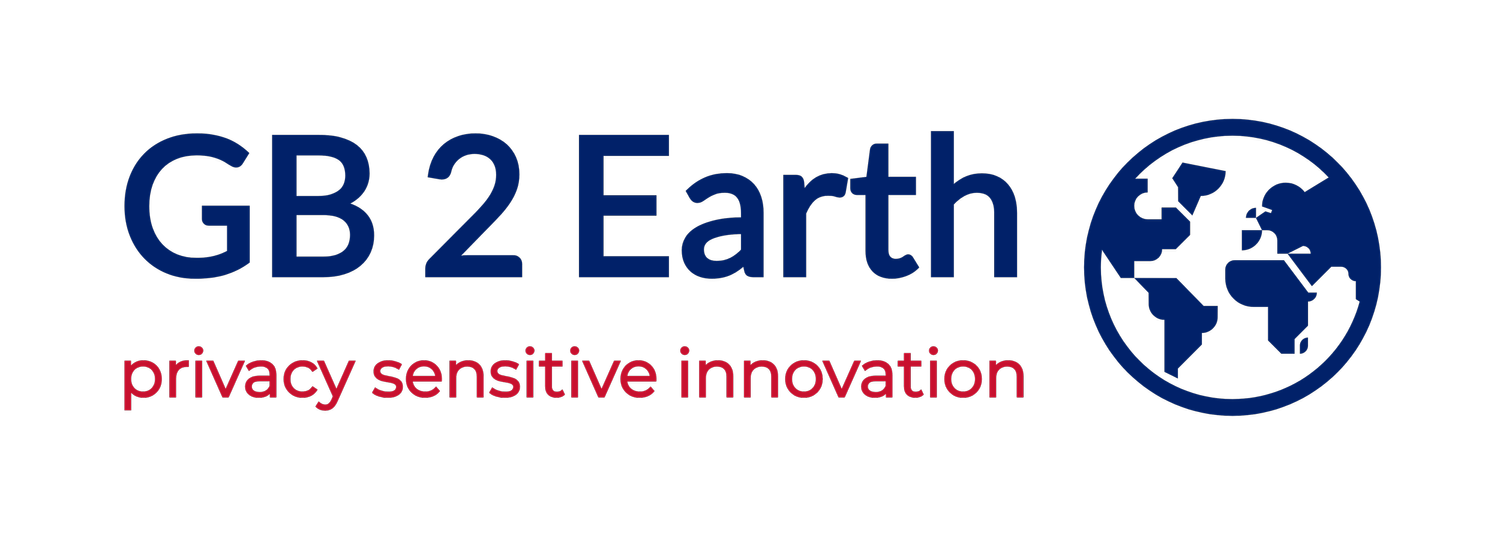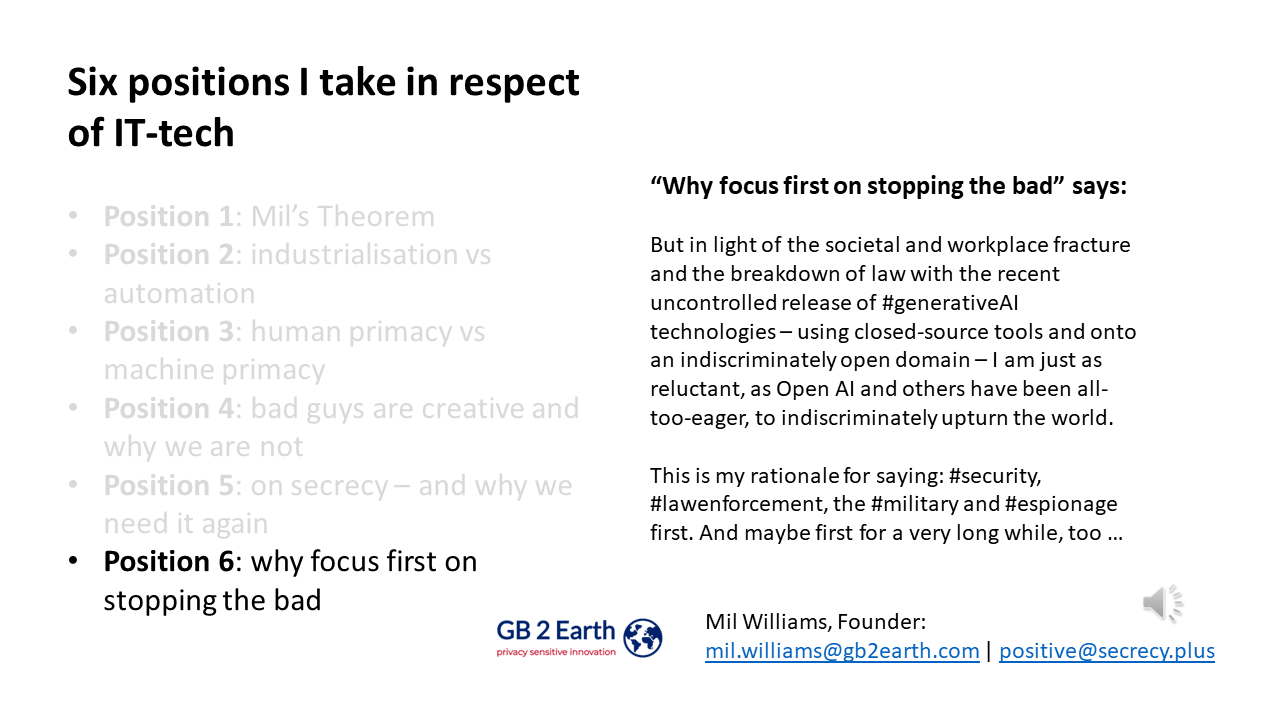Parallel lines: the bad AND the good
“After all, it’s not more tech we need: it’s more tech at the service of a newly empowered human that will really get the job done.
No?”
Introduction
In my slide-deck on six things that I felt needed to change in current IT- and AI-tech, Position 6 addressed why I felt we needed to deal with the bad before we progressed to working on the good.
Click here to watch and read this slide-deck.
The slide-deck, alongside the narrated video version, covers a lot of ground, and you’d probably get more out of it if you were able to unpick it with me over a period of an hour or so. There’s a lot packed into it, for sure.
But today I’ve chosen to focus on Position 6 only. And for a good reason. Because there’s no reason why we can’t work in parallel on different aspects of my ideas. Engagement from parties new to my ideas is needed for sure: but engagement, once achieved, changes everything.
This is Position 6:
The problem, of course, is that innovation and invention are effervescent. This doesn’t mean they are always allowed or enabled to happen. Strong forces disable a startup ecosystem and marketplace that would otherwise deliver far more good to a world clearly needful of a much more profound end-to-end analysis of the real problems we all know about.
It’s possible, then, that we have a problem here almost insoluble, practically intractible, in its apparently systemic gravity.
Let me run my view of all this past you first, and then you can decide:
Big tech (what we call loosely big tech) has a consulting function which decides what its clients need and then convinces them that whatever it says is the solution to all their ills. One example in the security industry is linked to below:
Because, unfortunately for most of big-tech’s clients, the consulting function in question is driven by the marketing function more than the engineering one. The consequence? Very often, too often, at all levels of tech too (not just big and Silicon Valley), standardised solutions get wrapped up in shiny marketing-inspired bespoke and made-to-measure giftwrap. It all then appears, to the relatively inexpert clients, that what they have is a box full of made-to-measure solutions worth paying hefty prices for, when actually only the wrapper is specific to them: the box itself, meanwhile, contains tools, platforms, architectures and software libraries which all their competitors — whatever the processes, workplaces and needs of each demand more specifically — are using just as inappropriately.
For, in truth, their big-tech partners in turn have pursued the same lines of approach: that is, out-and-out deception.
In the security field, which I’ve been pursuing most deeply these past six years or so (maybe longer), we have evidence now that big tech (loosely described, again) has been wilfully ignoring the lessons of the past two decades, as it has alighted, without exception amongst any of the corporations in question, on one business model and one only: that of outside-in surveillance architectures which prioritise machines and make humans mere extensions of the same.
What’s wrong with that?
9/11 happened because horrible humans out-thought all of us, using monstrously repurposed tools — aeroplanes — as extensions of their terrifying imaginations. In the meantime, our security orthodoxies, robust and firm to that moment, had argued it was enough to out-spy the bad guys into irrelevance.
I don’t, however, attribute blame to anyone, not even big tech, for what happened during 9/11. It blindsided us all. Such events exist in history: there’s nothing to be done but survive at such moments.
But once the moment has passed, there is something else to be done. More of the same, of course: an orthodoxy doesn’t lose its utility overnight. But not just more of the same. Learning has to take place too. We must always respect the enemy’s capacity and terrible intelligence, if we want, wish, need, some day, to revert to being better than them: if, sincerely, we aim to overcome.
Since then, Putin’s Russia and the war which, still, no one really understands, because our machine-primacy security orthodoxies are irrelevant in the face of such dreadful nonconformism:
https://gb2earth.com/cognitive
And last October 2023, Hamas hit us all in our collective solar plexus; thousands of missiles in residential communities; probably the planet’s most highly machine-surveilled space … all that big tech, and then so much more … and still it happened. Still we were blindsided — two decades after 9/11 — by a horror that continued to use machines as extensions of humans, in the face of big-tech’s consulting function’s ongoing insistence that all we needed was what benefitted their bottom lines most.
The solution?
Newly parallel lines: prevent the bad as, simultaneously, we do good — this is an idea I think others are also having, and perhaps rightly so, given that big tech owns security clients more than security clients own big tech.
We can’t rely on putting our new tools in the hands of a big tech which to date has not cared to promote what I thought up with very little resources to hand. And I say promote, because I don’t think I’m the only one who ever had these ideas: I do think I’m the only one who hasn’t yet taken big tech’s shilling.
So.
If you’ve been following the progression of my ideas over the past few months — here, last year at sverige2.earth, previously at secrecy.plus, and then again majorly on my LinkedIn feed — you’ll have read that I want to cover off, even fiercely control, several aspects of the whole software scoping and development processes, including the intervention of the corporate marketing function in all processes currently touched by it, so that what I now term #intuitionvalidation #biotools (built on existing IT- and AI-tech, for security and non-security purposes, both) and #bioweapons (being research-dependent tools primarily, and probably only for security and related) can be given a fair chance — a run for their money, if you like, where existing and traditional tech orthodoxies have chosen to never enable the same — of delivering an enhanced, optimised and expanded human intuition, arational thinking, high-level domain expertise, thinking without thinking, gut feeling, and sixth sense:
https://gb2earth.com/pgtps | early ideation of inside-out, non-surveillance tech, designed from the ground up to be #intuitionfriendly and #intuitionpositive
https://mils.page/ai | an early project — 2019 — presented to the UK government, where we proposed an #intuitionfriendly implementation of #ai
https://gb2earth.com/newlean | an #intuition- and #secrecypositive software discovery process, designed to deliver profitable, smaller-scale software projects in #ai and related fields
https://gb2earth.com/waste | an integrated #newlean and law-enforcement/counter-terrorism software development roadmap
https://gb2earth.com/cl-bio | #intuitionvalidation #biotools and #bioweapons — one of the most recent ideations
https://gb2earth.com/blog/corporation | why we must own the #consultingfunction if we seriously wish to create #intuitionvalidation software and hardware
Parallel lines: in more detail
To this minute, I’ve been proposing, using the Fortress Sweden IKEA-business figure of a three-layered entity, an intuition corporation called GB 2 Earth.
The eventual focus, in the light of previous security orthodoxies, was that it would take a long time for any of the technologies proposed to filter through into what I have to date called non-security applications.
It has been contemplated already on two pages here, however:
https://gb2earth.com/invest-sec | security & related applications only
https://gb2earth.com/invest-all | everything except security & related
Click here to read the blogpost and see the slide-deck above in full.
I think that the idea has also been sustained in the most recent tech-focussed ideation which can be found at the following two links:
https://gb2earth.com/cl-bio/consulting | #intuitionvalidation #biotools, built primarily on existing IT- and AI-tech
https://gb2earth.com/cl-bio/lab | here, what I call #bioweapons, built primarily on research-dependent technologies
As a result of all the above, today I have wondered, perhaps with the encouragement of others now finally engaging with my ideas, that we do, after all, need to emulate that great album by Blondie, “Parallel Lines”: that is to say, do it all, everything, everything we can put our minds to.
The idea in a nutshell
Here’s the idea in a nutshell, from notes I made on my iPhone’s Journal app earlier this afternoon.
The Fortress Sweden IKEA business-figure would be made up of the following three layers:
Layer 1 — SPT-IT (this stands for “Special Purpose Technology-IT”), with the necessary legal figure for its purpose.
Located in Sweden, preferably Stockholm; it can be neither bought nor sold (as per the IKEA model), thus making paradigmatic change-choices in global tech safe from larger, potentially marauding, tech competitors.
Also very hard for it to be influenced by other forces in a global context, including nation-states where the dangers from a creeping authoritarianism are all too manifest at the moment.
Responsible for strategising and deciding group policies across the board: HR, of course, but New Lean, the consulting function, and other related where impacting the capability of the group to deliver on its missions.
Layer 2 — SPT-IT Operations — the SPT-IT franchise owner, responsible for operational delivery of the franchisee layer (layer 3) plus day-to-day application of group policy in such matters.
Wholly owned by SPT-IT (layer 1).
Not possible, therefore, for it to be bought or sold.
Layer 3 — Secrecy Plus (country identifier) on the one hand and (Country name) 2 Earth on the other.
Both strands of activity are franchisees which can be entered or exited from, but never bought from or sold on to others.
Secrecy Plus franchisees will deliver #intuitionvalidation #biotools and #bioweapons (ie using existing and research-dependent technologies) for security, military, espionage & related sectors.
New Lean software discovery processes will always be used.
Our consulting function will develop, centrally, the tools and knowledge-base necessary to ensure our clients get what they need, not what big tech (when working in partnership with us) needs to sell them.
Each Secrecy Plus entity will have its own, connected 2 Earth entity, the protection of which — both physical, personnel-related, mission-based and institutional — shall be enabled by the group-wide research programmes carried out across the group by all security strands.
2 Earth franchisees will deliver #intuitionvalidation #biotools (ie using existing and potentially research-dependent technologies) for all fields of human endeavour except security & related.
Closing thoughts
I’d like to think that what I once called “The Gutenberg of Intuitive Thinking” — a printing-press for the arational side of human beings — might have an application sooner than later across all human endeavour.
The planet needs the solutions that such thinking, unleashed by a new kind of IT- and AI-tech with #intuitionfriendly and #intuitionpositive architectures, could deliver.
After all, it’s not more tech we need: it’s more tech at the service of a newly empowered human that will really get the job done.
No?






